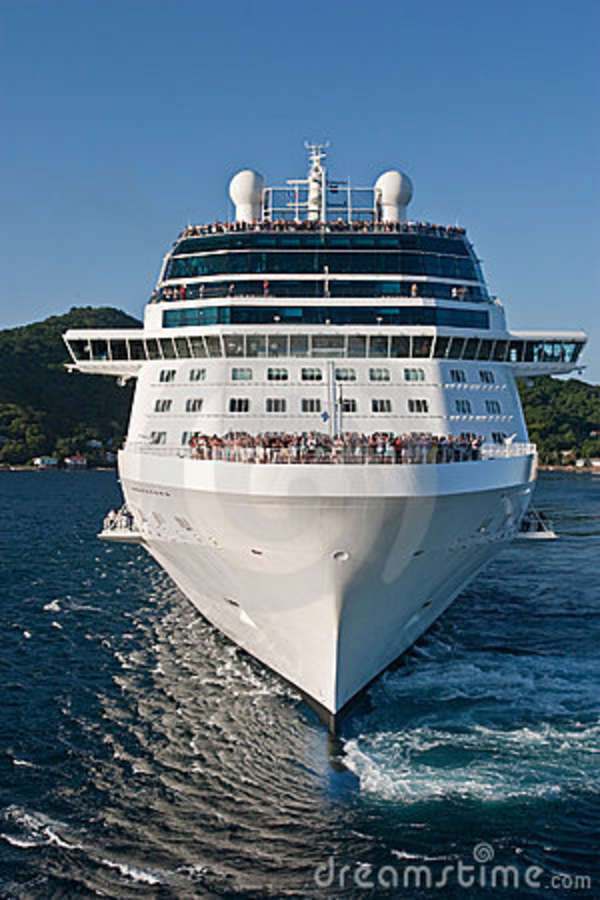
Many people when they see a big ship, particularly something like a cruise liner or an aircraft carrier, wonder how it does not tip over. This Page explains how.

Most people do not see any problem with the fore-and-aft stability of the ship, but in fact this is just as important. It is however more complex, so it is discussed later, but mainly for Advanced Readers.
Ships float because they displace a lot of water - this is discussed on another Page of this Web Site. If you have not already read this Page it might be helpful to do so now before you read the rest of this page.
Most single-hulled ships (that is, not catamarans etc) are longer than they are wide and approximately symmetrical about the centre line.

For a single-hulled ship we can consider the weight of a ship to be a single force acting through a single point, its centre of gravity, and the buoyancy of the water to be another single force acting through another single point, the centre of buoyancy. The centre of buoyancy is the point which would have been the centre of gravity of the water which the ship has displaced. For submarines, whether on the surface or submerged, the centre of buoyancy is usually above the centre of gravity, and this makes them very stable, but for most surface ships the centre of gravity is above the centre of buoyancy.
Single-hulled ships are normally designed so they float vertically and with the centres of gravity and buoyancy in a straight line.

But what happens if the ship tips slightly to one side (clockwise as I have drawn it), for example in a less than totally calm sea?
If the hull was absolutely circular (for example like a log with a mast fixed to the top) as the ship tilted the centre of gravity would move to the right but because the shape of the part of the log under the water does not change the centre of buoyancy does not move so the two forces are no longer in the same straight line.
There would be a turning moment trying to make it tip clockwise even further, and the ship would be unstable and would tip over until the mast was horizontal and floating on the surface of the water.
(You can see from these drawings that if the centre of gravity were below the centre of buoyancy, as the ship tipped the centre of gravity would move to the left not the right and the turning moment would bring the ship back to the vertical position - the ship would be stable. In a submarine the centre of gravity is below the centre of buoyancy.)
But if the hull was any other shape at all, as the ship tipped to one side both the centre of gravity and the centre of buoyancy would move.
Depending on the shape of the hull, one of four things will happen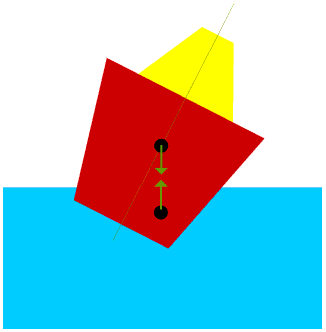
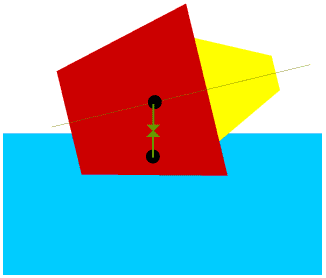
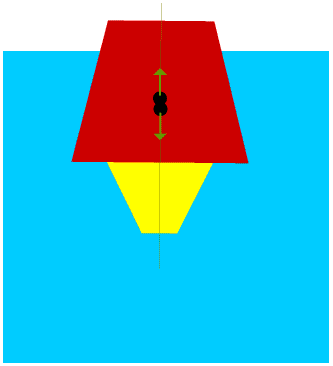
(Once a capsized ship has actually sunk and all gone under the waves it may roll over and be upside down when it reaches the bottom, but this is not quite the same.)
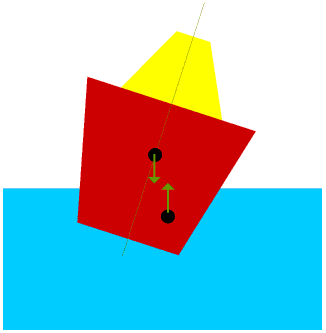
A more complete explanation of SHM is given in another page of my Web Site - to link to it please click here ![]()
The best way to investigate stability is to do some experiments.
You will need a bowl of water and a plastic cup, and any other containers, tins, jamjars, test tubes, bottles etc. you can find. I am not giving you any other instructions, but you can e-mail me with your questions, ideas and results if you like.
Don’t forget to make lots of waves so you can find out about listing, capsizing, turning turtle (you will find this difficult just by making waves!) and rolling.
Lifeboats necessarily go to sea in very dangerous conditions and are designed to right themselves if they turn turtle: to find out about self-righting and to see some pictures and videos of self-righting lifeboats do a web search on self-righting lifeboats. Lifeboats can be self-righting because everything moveable is fixed in place and all the crew are trained and wearing appropriate clothing; I am very uncertain about whether self-righting would be appropriate for any ship where these conditions do not apply, and as far as I know it has never been attempted (please e-mail me if you know better): much better not allow the ship to sail into situations where the weather might be so hazardous.
Catamarans and other multi-hulled ships and outrigger canoes etc are very stable because their design is such that any sideways tipping will always produce a very large righting effect.
Many modern merchant ships are designed to carry just one type of cargo: petroleum (crude oil), grain, bananas or new cars for example. So they have to make the return journey without any cargo, and need to carry lots of water as ballast. This water is taken in at one port and discharged at another, and this is creating very real problems of ecology, because many small animals such as jellyfish and crabs can be carried in this water and so moved to areas where they are not native. Without any natural predators they may then reproduce uncontrollably and this can have a devastating effect on the native wildlife.
As before, we can consider the weight of the ship and the buoyancy as single forces acting through the centre of gravity and the centre of buoyancy.

As the ship moves the centre of buoyancy moves in a way which makes it right itself, but it will overshoot, exactly as for rolling. This fore-and-aft motion is called pitching.
There is just one problem with pitching: as most ships are very much longer than they are wide the bow and stern move up and down considerable distances, 10 m for an aircraft carrier 300 m long for as little as two degrees each side of the horizontal. Not much fun for the crew of the aircraft carrier; even less for the pilot of an aircraft trying to land on it.
In rough seas the ship may pitch a lot more and the bow or stern, or of course both, may come down to the point at which the waves are breaking over it. Then there is a serious risk of the ship taking on water. But worse is to come.
If we lay a plank of wood on level ground and load it up with bricks it will quite happily support them.
If however we support the plank at only a few points there is a real chance of the plank breaking.
A big ship is not a single solid object, its hull is actually just a thin shell, and if it is pitching badly in very rough seas so that the buoyancy is not evenly distributed along its length the uneven stresses along its hull may make it break up.
Many ships sinking by the bow (taking on water through a hole near the bow), including the Titanic, have broken in half as the stern comes up out of the water as the bow goes down into it. Ships have even been known to break in half as they are being launched(!) which is why today many very large ships are built in a dry dock which is then slowly filled with water once the hull is watertight.
Icebergs are formed from glaciers and ice sheets in exactly the same way: the ice slides into the sea and a large lump eventually breaks off and floats away. Icebergs from the Antarctic ice sheets can be very big indeed.
The magnetic mine (so called not because it was attracted to the iron hull of the ship but because its explosion was triggered by the ship’s magnetism) of World War Two was dropped by German aircraft into the shallow waters near ports and dockyards round Britain and, until the Allies found out how it worked and could counteract it, was devastatingly effective. It sat on the bottom of the sea until the ship was exactly over it, then the explosion caused a huge wave to hit the middle of the ship and the ship broke in half and sank. There is more about this on the Magnetic Mine Page (under construction).
© Barry Gray February 2004, last revised January 2016